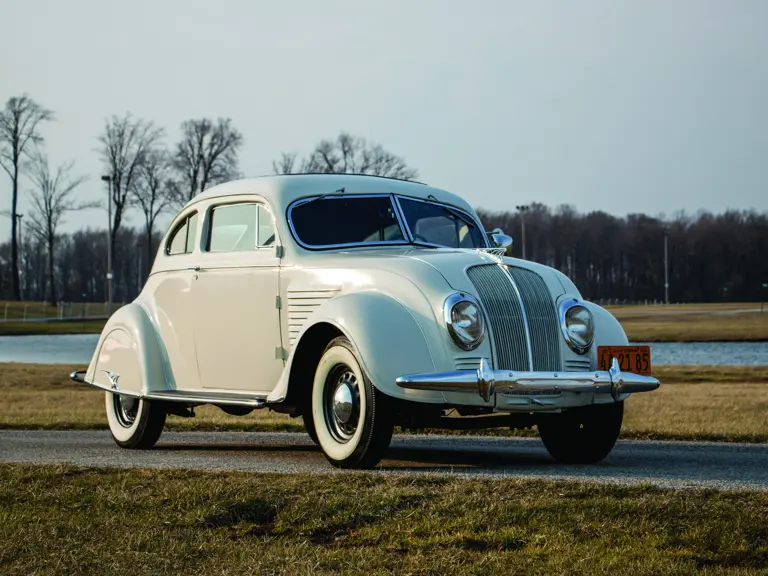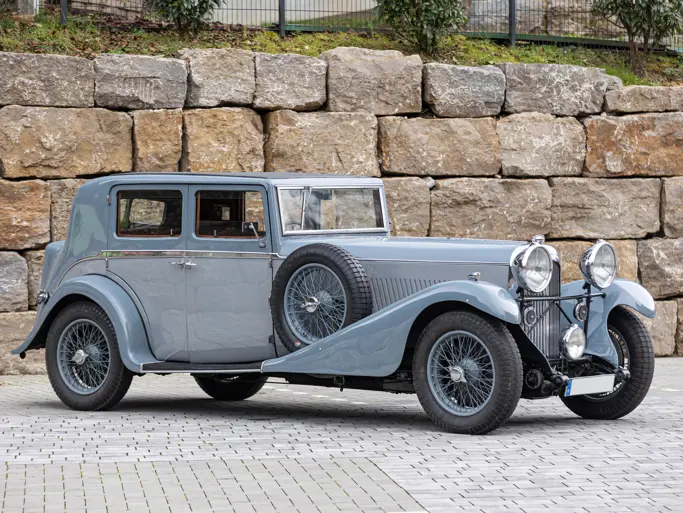
1934 DeSoto Airflow
{{lr.item.text}}
$50,000 - $60,000 USD | Not Sold
{{bidding.lot.reserveStatusFormatted}}
- 241.5-cid, 100-hp flathead six cylinder engine
- Three-speed manual transmission
- California car with known ownership since new
- One of only 1,584 coupes produced in 1934
- Cosmetically and mechanically restored as needed
- Factory hood ornament
- Front and rear bumper guards
- Fender skirts
- Driver spotlight
- Rear jumpseats
- Matching pair of 1934 California license plates
Chrysler Airflow factory literature in 1934 proclaimed the new car was “refreshingly different; delightfully spacious; the atmosphere of a smart modern penthouse; drawing room luxury;” and “unparalleled refinements and features.” A design far ahead of its time, the Airflow featured built-in headlamps and wider front seats that could accommodate three adults abreast. The hood was extended past the front axle, and the rear fenders had full fender skirts. There was also a rounded radiator grille and a modified vee-shaped windshield, further styling features that set this car apart from anything ever seen on North American shores.
In 1934 the entire DeSoto lineup featured Chrysler Corporation’s new streamlined Airflow design. Walter P. Chrysler expected the streamlined and futuristic Airflow models to take the nation by storm and to reap huge profits.
Not just an exercise in styling, the Airflow series was also a mechanical marvel, incorporating many new concepts in an effort to improve the driving experience. For improved handling, neutral weight distribution was attempted, and the body was lower to the ground thanks to a unit body construction and extra-long leaf springs. One of the major pay-offs of the Airflow design was greatly increased fuel consumption over traditionally styled vehicles of the era. Respected racer of the era, Harry Hartz, managed a cross-continental road trip from New York City to San Francisco, California with a total fuel bill of just $33.06, averaging better than 22 miles per gallon.
A truly unique car for the time, the Airflow wasn’t widely accepted by the buying public. Coupled with the height of the Depression, only 1,584 DeSoto coupes were built in 1934. Of them, reportedly only 15 are reported as being known to have survived.
This is a fine looking example that is reported as a California car with known ownership from new. It has been cosmetically and mechanically restored as needed, plus has the nice period accent of matching 1934 California license plates.
Running with a 241.5-cid, 100-hp inline six-cylinder engine with a three-speed manual transmission, the Airflow has many notable features that includes rear fender skirts, split rear window, crank-out windshield sections, stylish “waterfall” grille, driver’s side spotlight, front and rear bumper guards, artillery-style wheels, factory hood ornament and similar trim elements on the skirts.
The beautiful Art Deco appointments include period-style cloth interior, attractive dash and instrument design, chrome interior trim and jumpseats. The accents on this unique, but short-lived modern marvel included the unusual (for the time) width of the doors for simple entrance and exit; “you enter and leave through doors as wide as those in your home.”
This forward thinking Desoto is an exceptional example of both form and function and ready to be appreciated anew.


 | Auburn, Indiana
| Auburn, Indiana


